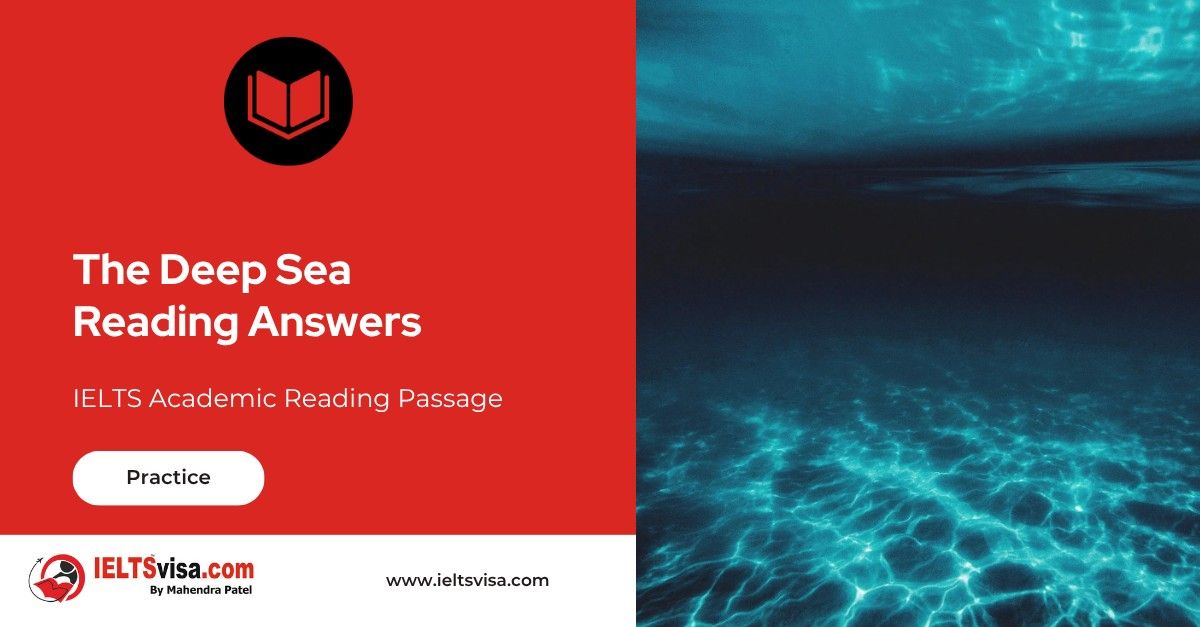The Deep Sea Reading Answers
IELTS Academic Reading Passage
At a time when most think of outer space as the final frontier, we must remember that a great deal of unfinished business remains here on earth. Robots crawl on the surface of Mars, and spacecraft exit our solar system, but most of our planet has still never been seen by human eyes. It seems ironic that we know more about impact craters on the far side of the moon than about the longest and largest mountain range on earth. It is incredible that human beings crossed a quarter of a million miles of space to visit our nearest celestial neighbour before penetrating just two miles deep into the earth own waters to explore the Midocean Ridge. And it would be hard to imagine a more significant part of our planet to investigate – a chain of volcanic mountains 42,000 miles long where most of the earth’s solid surface was born, and where vast volcanoes continue to create new submarine landscapes.
The figure we so often see quoted 71% of the earth’s surface – understates the oceans’ importance. If you consider three-dimensional volumes instead, the land dwellers’ share of the planet shrinks even more toward insignificance: less than 1% of the total. Most of dying oceans’ enormous volume lies deep below the familiar surface. The upper sunlit layer, by one estimate, contains only 2 or 3% of the total space available to life. The other 97% of the earth’s biosphere lies deep beneath the water’s surface, where sunlight never penetrates. Until recently, it was impossible to study the deep ocean directly. By the sixteenth century, diving bells allowed people to stay underwater for a short time: they could swim to the hell to breathe air trapped underneath it rather than return to the surface. Later, other devices, including pressurized or armoured suits, heavy metal helmets, and compressed air supplied through hoses from dying surfaces, allowed at least one diver to reach 500 feet or so. It was 1930 when a biologist named William Beebe and his engineering colleague Otis Barton sealed themselves into a new kind of diving craft, an invention that finally allowed humans to penetrate beyond the shallow sunlit layer of the sea and the history of deep-sea exploration began. Science then was largely incidental – something that happened along the way. In terms of technical ingenuity and human bravery, this part of the story is every bit as amazing as the history of early aviation. Yet many of these individuals, and the deep-diving vehicles that they built and tested, arc not well known.
It was not until the 1970s that deep-diving manned submersibles were able to reach the Midocean Ridge and begin making major contributions to a wide range of scientific questions. A burst of discoveries followed in short order. Several of these profoundly changed the whole field of science and their implications are still not fully understood. For example, biologists may now be seeing – in the strange communities of microbes and animals that live around deep volcanic vents – clues to the origin of life on earth. No one even knew that these communities existed before explorers began diving to the bottom in a submersible. Entering the deep, black abyss presents unique challenges for which humans must carefully prepare if they wish to survive. It is an unforgiving environment, both harsh and strangely beautiful, that few who have not experienced it firsthand can fully appreciate. Even the most powerful searchlights penetrate the only lens of feet. Suspended particles scatter tile light and water itself is less transparent than air; it absorbs and scatters light. The ocean also swallows other types of electromagnetic radiation, including radio signals. That is why many deep-sea vehicles dangle from tethers. Inside those tethers, copper wires or fibre optic strands transmit signals that would dissipate and die if broadcast into open water.
Another challenge is that the temperature near the bottom in very deep water typically hovers just four degrees above freezing, and submersibles rarely have much insulation. Since water absorbs heat more quickly than air, the cold down below seems to penetrate a diving capsule far more quickly than it would penetrate, say, a control van up above, on the deck of the mother ship. And finally, the abyss clamps down with crushing pressure on anything that enters it. ‘This force is like air pressure on land, except that water is much heavier than air. At sea level on land, we don’t even notice 1 atmosphere of pressure, about 15 pounds per square inch, the weight of the earth’s blanket of air. In the deepest part of die ocean, nearly seven miles down, it’s about 1,200 atmospheres, 18,000 pounds per square inch. A square-inch column of lead would crush down on your body with equal force if it were 3,600 feet tall.
Fish that live in the deep don’t feel the pressure, because they are filled with water from their environment. It has already been compressed by abyssal pressure as much as water can be (which is not much). A diving craft, however, is a hollow chamber, rudely displacing the water around it. That chamber must withstand the full brunt of deep-sea pressure – thousands of pounds per square inch. If seawater with that much pressure behind it ever finds a way to break inside, it explodes through the hole with laserlike intensity. It was into such a terrifying environment that the first twentieth-century explorers ventured.
Questions 27-30
Write the correct letter. A. B. C or D, in boxes 27-30 on your answer sheet.
Question 27. In the first paragraph, the writer finds it surprising that …
- we send robots to Mars rather than to the sea bed.
- we choose to explore the least accessible side of the moon.
- people reached the moon before they explored the deepest parts of the earth’s oceans.
- spaceships are sent beyond our solar system instead of exploring it.
Question 28. The writer argues that saying 71 % of the earth’s surface is the ocean is not accurate because it …………………
- ignores the depth of the world’s oceans.
- is based on an estimated volume.
- overlooks the significance of landscape features.
- refers to the proportion of water in which life is possible.
Question 29. How did the diving bell help divers?
- It allowed each diver to carry a supply of air underwater.
- It enabled piped air to reach deep below the surface.
- It offered access to a reservoir of air below the surface.
- It meant that they could dive as deep as 500 feet.
Question 30. What point does the writer make about scientific discoveries between 1930 and 1970?
- They were rarely the primary purpose of deep-sea exploration.
- The people who conducted experiments were not professional scientists.
- Many people refused to believe the discoveries that were made.
- They involved the use of technologies from other disciplines.
Questions 31-36:
Do the following statements agree with the views of the writer in Reading Passage 3?
In boxes 31-36 on your answer sheet, write
YES, if the statement agrees with the views of the writer
NO, if the statement contradicts the views of the writer
NOT GIVEN, if it is impossible to say what the writer thinks about this
Question 31. The Midocean Ridge is largely the same as when the continents emerged.
Question 32. We can make an approximate calculation of the percentage of the ocean in which sunlight penetrates.
Question 33. Many unexpected scientific phenomena came to light when the exploration of the Midocean Ridge began.
Question 34. The number of people exploring the abyss has risen sharply in the 21st century.
Question 35. One danger of the darkness is that deep-sea vehicles become entangled in vegetation.
Question 36. The construction of submersibles offers little protection from the cold at great depths.
Questions 37-40:
Complete the summary using the list of words A-I below.
Write your answers in the boxes next to 37-40 on your answer sheet
Deep diving craft
A diving craft has to be 37 …………………………………enough to cope with the enormous pressure of the abyss, which is capable of crushing almost anything. Unlike creatures that live there, which are not 38……………………………………..…. because they contain compressed water, a submersible is filled with 39…………………………………………….. If it has a weak spot in its construction, there will be a 40…………………………………… explosion of water into the craft.
- an ocean
- air
- deep
- hollow
- sturdy
- atmosphere
- energetic
- violent
- heavy

Solution For: The Deep Sea
Reading Answers
| 27 | C |
| 28 | A |
| 29 | C |
| 30 | A |
| 31 | NO |
| 32 | YES |
| 33 | YES |
| 34 | NOT GIVEN |
| 35 | NOT GIVEN |
| 36 | YES |
| 37 | E |
| 38 | D |
| 39 | B |
| 40 | H |
Review and Practice
- Regularly practice with IELTS reading samples and time yourself to get used to the pressure of the exam.
- Review your mistakes to understand where you went wrong and how to avoid similar errors in the future.
Our Books
Master IELTS Speaking Part 1
IELTS Writing Task 1 Book
IELTS Writing Task 2 Book
The Deep Sea Reading Answers Explanation
Comin Soon
Practice IELTS Other Modules
IELTS Listening
The IELTS Listening test assesses how well you can understand spoken English in various contexts. It lasts about 30 minutes and is divided into four sections with a total of 40 questions. The listening tasks become increasingly difficult as the test progresses.
IELTS Academic Reading
The IELTS Academic Reading section assesses your ability to understand and interpret a variety of texts in academic settings. It is designed to evaluate a range of reading skills, including skimming for gist, reading for main ideas, reading for detail, understanding inferences, and recognizing a writer's opinions and arguments.
IELTS Speaking
The IELTS Speaking test assesses your ability to communicate in English on everyday topics. It lasts 11-14 minutes and consists of three parts: introduction, cue card, and a discussion based on the cue card topic.
IELTS General Reading
IELTS General Reading tests your ability to understand and interpret various types of texts. Here are some key areas and types of content you can expect to encounter in the reading section, along with tips for effective preparation.
IELTS Academic Writing Task 1
In IELTS Academic Writing Task 1, you are presented with a visual representation of information, such as graphs, charts, tables, or diagrams, and you are required to summarize, compare, or explain the data in your own words.
IELTS General Writing Task 1
In IELTS General Writing Task 1, you are required to write a letter based on a given situation. The letter can be formal, semi-formal, or informal, depending on the prompt. Here’s a breakdown of the key components to include in your letter
IELTS Academic Writing Task 2
In IELTS Academic Writing Task 2, you are required to write an essay in response to a question or topic. Here’s a guide to help you understand the essential elements of this task
IELTS Exam Tips
To succeed in the IELTS exam, practice regularly, familiarize yourself with the test format, improve your vocabulary, develop time management skills, and take mock tests to build confidence.
Grammer for IELTS
Grammar is the foundation of effective communication in English. Understanding tense usage, subject-verb agreement, and sentence structure enhances clarity and coherence in writing and speaking.
Vocabulary for IELTS
Vocabulary plays a crucial role in the IELTS (International English Language Testing System) exam, especially in the Speaking and Writing sections. Here’s an overview of why vocabulary is important and how it impacts your performance
RECENT IELTS SAMPLES QUESTIONS AND ANSWERS
Ebonics Reading Answers
A. Ebonics - also known by a host of other names such as African American Vernacular English,...
A Disaster Of Titanic Proportions
A. At 11:39 p.m. on the evening of Sunday, 14 April 1912, lookouts Frederick Fleet and...
Vitamins To supplement or not?
Mineral, vitamin, and antioxidant health supplements make up a multi-billion-dollar industry...
The Hollywood film industry
A. This chapter examines the ‘Golden Age’ of the Hollywood film studio system and explores how...
Three Dimensional Films Reading Answers
A. In the theatre of the Ambassador Hotel in Los Angeles, on the evening of 27 September 1922,...
The Developing World Reading Answers
A THE DEVELOPING WORLD — the economically underdeveloped countries of Asia. Africa. Oceania...













